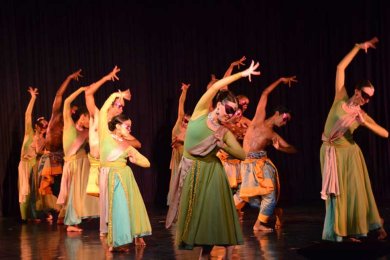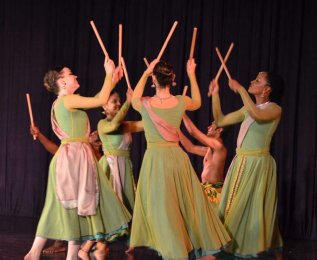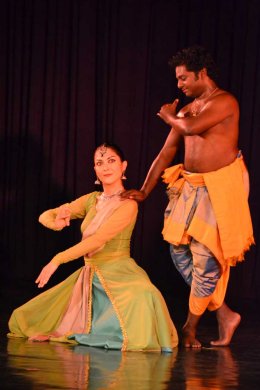
|   |

|   |
 e-mail: sunilkothari1933@gmail.com Daniel Phoenix Singh Dance Company perform in India November 27, 2016 (Photos are from performance at Kalakshetra, Chennai, courtesy Kalakshetra) It was indeed a pleasant surprise during a crowded week to attend a dance performance of Dakshina Daniel Phoenix Singh Dance Company at Gandharva Mahavidyalaya's Sannidhi Auditorium in Delhi. I have met Daniel in Washington DC and attended a few performances during my visits. He has been doing excellent work. Dakshina is a dynamic and diverse dance company led by him. Daniel has chosen the name Dakshina, meaning "offering" in Sanskrit and in keeping with this spirit, Dakshina is offering artists and communities the unique opportunity to experience dance as a movement that links the arts, cultures and social causes. 

Founded in 2003, Dakshina has in recent years, examined the connections between Indian, social, and modern dance forms, brought dance out of the auditorium and into schools and community centres, and pushed the boundaries of the form through the use of film, interviews, popular music, and theatre. The company connects traditions with trend-setting work and pushes participants to approach dance in a thought provoking manner. Dakshina has a unique mission of both performing and presenting leading artists and emerging artists side-by-side to create a dialogue across generations and cultures. In their India tour, their first presentation was in Delhi, followed by performances in Bangalore and Chennai. Their presentation included Chakra, dealing with Chakravyuha story from Mahabharata, September Sonata choreographed by legendary American choreographer Anna Sokolow and Tulsi, based on mythological stories of Tulsi aka Sati Vrindavati. Chakra with dancers of the company in their billowing costumes, in a technique which combines classical Bharatanatyam and modern dance, was impressive. Suggesting weapons, holding plastic elastic cases with bulbs, and waving them, Abhimanyu turning them into chariot's wheel creates fascinating patterns. Dancing with controlled energy and leaps, they surround Abhimanyu. Not knowing how to get out of the circular formation, though he knew how to enter and fight, Abhimanyu gets killed. Uttara, wife of Abhimanyu, visits the battlefield and finds his body among other dead soldiers. It is a heart breaking poignant story that communicates through imaginative, well constructed choreography using the space dynamically, seamlessly combining Bharatanatyam and modern dance techniques. The use of footwork for confrontation for war, with attacks and defence, enhanced the impact. The use of large floor gave them enough room to explore the space. September Sonata in a duet with its serene mood, almost like a prayer conveyed the emotions with simple hand gestures and bodily movements. Through barest minimum austere movements the choreographic piece reveals the genius of Anna Sokolow. Daniel has been following her works with devotion and deep engagement. A female dancer and Daniel performed the piece with sincerity.  Daniel has re-imagined the story. The story of Tulsi being seduced by Krishna is told. During a masked ball at Tulsi's husband Jalandhar's palace where they dance with their courtiers, Krishna joins in disguise. Jalandhar had grown so powerful that gods send Krishna to break Jalandhar's might. Krishna at the peak of the ball, switches places with Jalandhar and seduces Tulsi, who when she realizes that she was tricked curses Krishna to turn into stone as Shaligram. As flashback Tulsi tells Rukmini this story that as a fallen woman she had no choice but to marry Krishna, despite being blameless. Tulsi offers a leaf to Rukmini and assures her that her devotion will outweigh Krishna in balance. Rukmini places the leaf of Tulsi on the balance and it outweighs Krishna's side of the balance. In Daniel's version of choreography he has used a male dancer with extended hands as balance and Krishna sits on one side, the other arm is raised to suggest the side of Krishna is heavy touching the floor. The entire episode is choreographed imaginatively. Indian mythological stories have many versions. The stories are known and therefore communicate through dance easily, as also the synopsis is told in advance. Daniel has portrayed in Tulsi's character women who have been denied justice, who are victim of men, who suffer at men's hands and he has interpreted symbol of Tulsi as a victim, as Tulsi speaks in the end, why Draupadi was humiliated, why Sita had to go through fire and why women have to suffer. It resonates with the plight of women of present day. Tulsi says that when Krishna wears garland of Tulsi, let the garland constantly remind him of the injustice done to her. And let people know through this symbolic tale the plight of women. This was said as voice over by Anu Yadav for Tulsi. The group performs with complete ease both Bharatanatyam and modern dance. The company members travelling in India were Alessandra, Pizza Julia Battist, Jamal Ari Black, Valerie Branch, Helen Marie Carruthers, Darrel Daney, Rohini Dhananjaya, Dhanoop Perumpara Kuttappan, Daniel, Sharugash Swargaloganathan and Richard Turner. Daniel acknowledges Sudha Radhakrishnan and Helen Marie Curruthers for creative process and Madhvi Venkatesh as assistant choreographer. For music Pandit Jasraj, Alif Laila, Mychael Danna and others. Special credit is given for music of Raas to Alif Laila and costumes to Judith Hanse. Daniel and his company continue to build bridges between different cultures through dance. He also holds an annual dance festival. Over several years he has been inviting leading exponents like Dhananjayans, Leela Samson, Mallika Sarabhai, Anita Ratnam, Rama Vaidyanathan and Madhavi Mudgal presenting them in performances and workshops. This augurs well for the company and Indian Diaspora dancers in Washington DC.  Dr. Sunil Kothari is a dance historian, scholar, author and critic. He is honored with Padma Shri, Sangeet Natak Akademi award and Senior Critic Award from Dance Critics Association, NYC. Post your comments Please provide your name and email id when you use the Anonymous profile in the blog to post a comment. All appropriate comments posted with name & email id in the blog will also be featured in the site. |